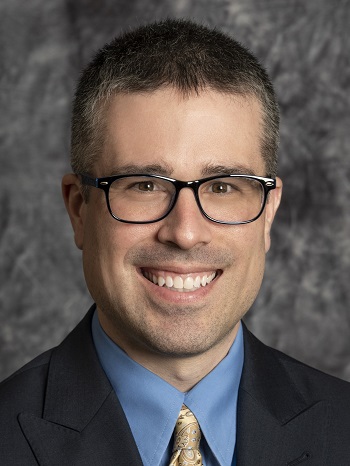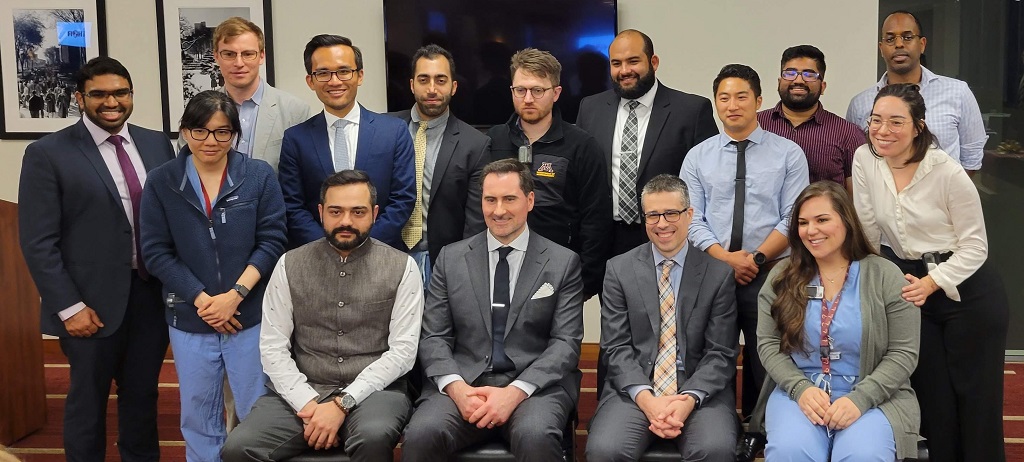
Graduating residents taking a variety of skills with them to their next challenge
Photo caption: (standing, left to right) Drs. Carolina Sandoval, Mayur Sharma, Daniel Guillaume, Andrew Venteicher, Stefan Kim, Walter Galicich (HCMC), Michael Park, Ramu Tummala, Robert McGovern, Thomas Bergman (HCMC), and David Darrow. Seated, left to right: Dr. Nelson Oyesiku (Chou Lecturer, North Carolina University, Chapel Hill), Dept. Head Clark C. Chen, graduating residents Drs. Bryan Ladd and Sam Cramer, and former Dept. Head Stephen Haines.
Congratulations to our Chief Residents who commemorated their seven-year journey with the U of M during their graduation celebration on June 23, 2023. Sam Cramer, MD, PhD, and Bryan Ladd, MD, were interested in more than just learning about excellent patient care during their residency. Their research interests are helping to advance the practice of neurosurgery and each has made – and are making – tangible contributions to the medical device field.
Sam Cramer

Cramer (pictured here) was astonished by how quickly the seven years of his residency went by. “One of my chiefs frequently told me that the days are long, but the time is short,” he said. “What she meant is that we need to learn as much as possible while we’re in residency because the time goes quickly. I tried to remember that every day.”
When he first started his residency, Cramer wanted to focus on functional neurosurgery and the use of neurostimulation to treat his patients. “I quickly determined that wasn’t for me, so I took a step back to re-evaluate both my clinical and research interests,” he said. “That led to me focusing on general neurosurgery from a clinical standpoint and on traumatic brain injury [TBI] from a research standpoint. While this took me in a different direction than I anticipated at the beginning, I am still very interested in the application of neuromodulation for the treatment of traumatic brain and spinal cord injuries.”
Research focus
In his research, Cramer explored different diagnostic modalities for TBI. “I’ve been working in a mouse model to develop ways to characterize brain activity that could be used as a diagnostic tool, monitoring therapeutic responses to medications or neuromodulation,” he said. “The changes we observe with the imaging technique I’m using in these mice may help monitor those responses.”
In 2019, Cramer was granted a provisional U.S. patent for a traumatic brain injury catheter. He partnered with faculty members David Darrow, MD, MPH; and Andrew Grande, MD; and U of M Neuroanatomy Lab Director Sean Moen on the device.
Cramer also worked on several clinical trials during his residency. “One looked at abnormal electric activity in the brain called cortical spreading depolarization and how that’s monitored and captured in TBI,” he said. “We don’t have a way to monitor for it at this point and it’s something that is present in many severe TBI patients. It represents potential opportunity to improve patient outcomes.”
Coping mechanisms
Because he focused on treating and researching traumatic brain injury, Cramer developed coping mechanisms to help him deal with the trauma to which he’s exposed. “They included surrounding myself with a strong team that understands the challenges that come with treating this patient population,” he said. “In addition, my wife, Julie, cares for premature infants who often have various forms of illness. We can talk to each other about our challenges.”
Specific goals
Cramer had specific goals for his final year in residency. “During my time at Hennepin Healthcare [in Minneapolis,] I wanted to become much more comfortable with different approaches to treating spine issues,” he said. “I also familiarized myself with different cranial approaches for brain tumor resection and other pathologies in the head.”
After graduation, Cramer plans to join the Neurosurgery Department at Hennepin Healthcare. In his spare time, he enjoys spending time with his wife and three children, Theodore (7), Scarlett (6), and William (8 months).
Bryan Ladd

When Ladd (pictured here) began his residency, he was interested in intracranial pathology. As he gained more experience in spine surgery, however, his focus changed. “The technical nuances and decision making involved in spine surgery really caught my interest,” he said.
To further his education about spinal procedures, Ladd completed a yearlong enfolded fellowship with the U’s Orthopedics Department and will complete another spine fellowship at Johns Hopkins after graduation.
Patient impact
With his work in spine came a growing awareness of the impact of these procedures on patients. “Because we do a lot of large, open spinal surgeries, we also do a lot of work with our patients to help them manage their post-operative pain,” he said. “Seeing the impact these procedures have on the patient made it obvious to me that, when possible, I should use a less invasive approach.”
Before completing his medical degree at the University of Minnesota, Ladd worked for five years in the medical device industry as a senior R&D engineer. He was involved to some extent in all the phases of the medical device development lifecycle. It was that experience that inspired him to pursue his medical education. With his background in mechanical engineering, Ladd enjoys investing time in innovative projects.
In addition to several spine-related research projects, he was involved in product development efforts during his residency – two paired with industry and one he developed himself. “It’s a wound closure device that I’ve been working on with the U’s Medical Device Center,” he said. The work was granted a provisional patent and he hopes to continue working on the project after graduation.
An incredible seven years
During his final year, Ladd performed other types of neurosurgical procedures, such as complex surgical approaches for brain tumors, aneurysms, and vascular bypasses. “Since I had been focused on spine, it was good to get back to some complex intracranial pathology to ensure that I have that as a skillset going forward,” he said.
Ladd and his wife, Jenna, live with their three kids (6, 4, and 2) and one cat (Missy) in Plymouth, MN. “We love to go to the local parks,” he said. “During winter, the kids like to sled in French Park.”
When asked about the best advice that he received during his residency, Ladd said, “I need to smile more…I’m still working on it.” (As you can see in the photo below, he's succeeding! Ladd and Cramer join fellow residents (standing, left to right) Drs. Anudeep Yekula, Shiwei Huang, Dominic Gessler, Huy Do, Youssef Hamade, Sam Jones, Ahmed Elbermawy, James Baek, Anant Naik, Birra Taha, and Isabela Peña Pino. Seated (left to right): Drs. Sanjay Dhawan, Ladd, Cramer, and Crina Peterson.




